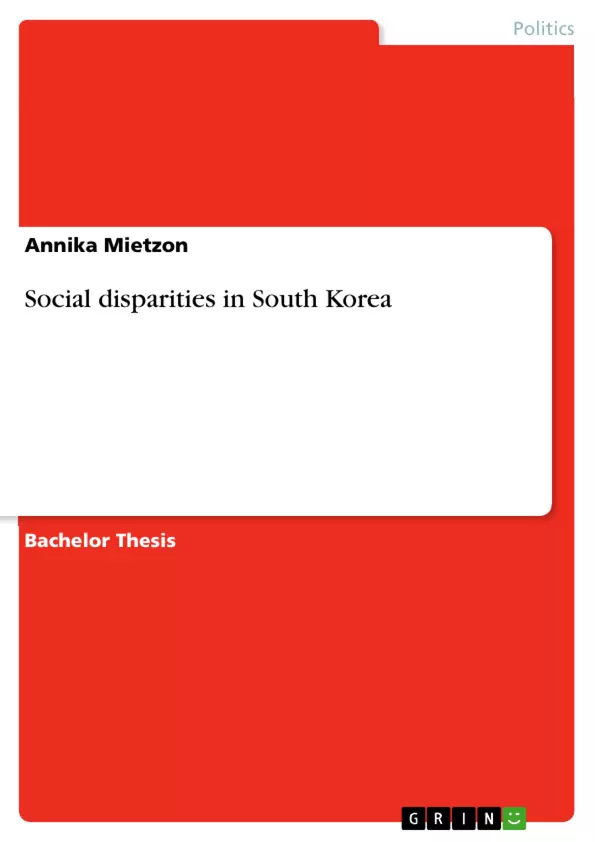Over the last six decades, the Republic of Korea experienced rapid economic and social development. Korea was able to ascend from the destruction of the Korean War and grow to the 15th largest economy in 2009 in Gross domestic products (GDP) terms.
Especially, the introduction of heavy and chemical industries (HCI) in the beginning of the 1970s influenced economic growth and social development strongly. While the living standards during the 1950s were similar to the standards in the poorest countries today, today Korea is one of the leading industries worldwide.
However, the mid-1990s were a turning point for inequality trends in Korea, caused by certain events like the Asian Financial Crisis (AFC) and the change of political power in 1997. This thesis analyzes and discusses the changes in inequality trends since the beginning of the 1990s until now. The focus lies on income inequality trends, the sources, and whether and to which extent it affects education inequality.
First, the theoretical framework is defined and explained. This thesis concentrates on interpreting income inequality by using mainly the GINI coefficient and income deciles. The methodology of income measures are elaborately described. The following chapter focuses on the Great Gatsby curve and social mobility. For this thesis, vertical intergenerational mobility is a matter of special importance, therefore, the paper unfolds the relationship between education and intergenerational mobility.
The third chapter, covers the main part of this thesis and starts with a general overview over the development in social structures since the 1980s. This section deals with the GDP growth rate trends, Korea’s decreasing fertility rates as well as labor market polarization and briefly identifies the reasons. Further consequences arising from e.g. a polarization of the labor market are addressed in the following chapter. It analyzes income inequality in general as well as in detail by focusing on GINI coefficients, decile ratios, and the trend of share of households.
Furthermore, it explains the sources behind an increasing income inequality, especially, regarding wage trends. The last section describes education trends during the last couple of years by analyzing expenditure and participation rates for private tutoring. It also briefly analyzes the contribution of education to intergenerational mobility and tries to answer whether income inequality leads to disadvantages among students.
Inhaltsverzeichnis (Table of Contents)
- Introduction
- Theory
- Inequality measures - GINI coefficient and decile ratios
- The Great Gatsby Curve and Social Mobility
- Social disparities in South Korea
- An overview over development in social structures since the 1980s
- Income inequality – trends and driving forces
- Education and Social Mobility
- Conclusion
Zielsetzung und Themenschwerpunkte (Objectives and Key Themes)
This bachelor thesis examines the development and current state of social disparities in South Korea. It aims to provide an analysis of the main trends and driving forces behind income inequality and its impact on social mobility, focusing particularly on the role of education. The thesis relies on relevant theoretical frameworks, such as the GINI coefficient and the Great Gatsby Curve, to analyze the data and provide a comprehensive understanding of the issue.
- Social and economic development in South Korea since the 1980s
- Trends and factors influencing income inequality
- The role of education in shaping social mobility
- The impact of social disparities on various aspects of society
- Comparison of South Korea's social disparities to other developed nations
Zusammenfassung der Kapitel (Chapter Summaries)
The Introduction provides an overview of the topic of social disparities in South Korea, outlining the importance and relevance of the study. It establishes the research question and objectives, as well as the theoretical framework used in the analysis.
The Theory chapter introduces key concepts and measures related to income inequality and social mobility. It delves into the GINI coefficient and decile ratios as indicators of income disparities, exploring their strengths and limitations. The chapter also introduces the Great Gatsby Curve, a framework for analyzing the relationship between income inequality and intergenerational social mobility.
The chapter on Social disparities in South Korea provides a comprehensive analysis of the development and trends in social structures since the 1980s. It examines the drivers of income inequality, including economic growth, technological advancements, and policy changes. The chapter further analyzes the role of education in shaping social mobility, focusing on the impact of educational policies and disparities on opportunities and outcomes.
Schlüsselwörter (Keywords)
The key terms and concepts explored in this thesis include social disparities, income inequality, social mobility, GINI coefficient, decile ratios, the Great Gatsby Curve, education, South Korea, economic development, and policy analysis.
- Quote paper
- Annika Mietzon (Author), 2016, Social disparities in South Korea, Munich, GRIN Verlag, https://www.grin.com/document/1312484



